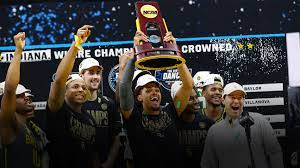It is that time of year again. Procrastinating on school and work to watch the games. Filling out a perfect bracket, that will inevitably be ruined less than three hours in on the first day. Tuning in to watch every second of every game. Rooting for a school that you have never heard of to be a Cinderella story. It is March Madness.
Millions of people’s favorite tradition, besides complaining about their favorite team’s performance, is to fill out brackets. The goal is to correctly guess the outcome of 68 different teams playing in 65 different games, plus the score of the championship game. What do you win? A variety of things. You could win the pool of money from a group of friends, a prize from your office, or just pride in your family. The chances of you getting that perfect bracket, however, are 9.2 quintillions.
Methods to Fill A Bracket
There are many methods to fill out a perfect bracket, and some will do better than others depending on your level of expertise. I will go through all of them and give a brief breakdown of each.
Traditional
This is the method that I personally use to fill out mine. This does require at least a basic understanding of college basketball. This method combines picking the higher-seeded better teams winning the majority of teams with picking a few lower-seeded teams that you think are underdogs not respected by the selection committee.
Pros: Usually works the best and provides a great feeling when you predict an unpredictable upset.
Cons: Takes more time than most of the other methods, and causes the most stress when the team you picked to win it all gets knocked out in the second round.
Higher Seeds
This method involves only picking the higher-seeded teams. This means that the Final Four will only be top seeds. It usually works, however, it does not take into account any upsets.
Pros: Gets a mostly accurate bracket, as the higher-seeded teams tend to win most of the early matchups.
Cons: Does not have any upsets. Also does not do well the middle seeds in the first round and the higher seeds in the later rounds.
Many Upsets
This is the exact opposite of the method above. Picking all the underdogs. This tends to be pretty inaccurate, however pretty fun.
Pros: Get to brag about predicting the unforeseen upsets to all your friends like when UMBC beat Virginia, the first and only time a 16-seed has ever beaten a 1-seed.
Cons: Tends to be very inaccurate and will probably get you last in your pool.

History
This method picks the teams based on their past history in March Madness. This method will pick traditional schools that dominate in basketball, primarily the Blue Bloods, a group of older teams that once won dominated college basketball, such as Duke or North Carolina to win the championship. This doesn’t take into account any of the modern teams that are taking over.
Pros: Many of the traditionally good basketball schools are still solid if not great at basketball still.
Cons: Some of the teams that have emerged recently, such as Baylor or Auburn, will probably do better than teams that aren’t as great anymore, such as North Carolina.
Mascots
This method is unique in comparison to others as it takes literally no knowledge of basketball to complete the bracket. The way to pick the winners of each game is to decide which mascot would win in a fight.
Pros: It works decently this year as two of the number one seeds are solid contenders to win in this bracket too, the Baylor Bears and Arizona Wildcats.
Cons: The overall top seed, the Gonzaga Bulldogs, are probably a first-round exit. Also, what do you do for made-up mascots such as the Kansas Jayhawks?
Feelings
This method takes into account your feelings and past experiences with each school. Had a friend who went on a visit once to a school? Pick them to win. Have a teacher you don’t like who went to that college? Choose the other team to beat them. If you are indifferent to both the teams then you can use any of the above methods to choose the winner of the matchup.
Pros: You feel good about the winner of your bracket, and you have a team who you can truly cheer for because you want them to win and they will not mess up your bracket if they do.
Cons: The losses hurt even more. Your family favorite team’s loss can ruin your day, and your bracket.
Random Guessing
This method involves exactly what the title says. Randomly guess each of the matchups to decide your March Madness champion.
Pros: You can randomly guess a great bracket.
Con: You can randomly guess a terrible bracket.
Tips and Tricks
If you go the traditional route it is important to consider a few different statistics when deciding on each matchup.
Always pick the 1-seed over the 16-seed. Always. The 16 has only beat the 1 seed once in history out of 136 different games. Pick the 1-seed. Please.
Take into account teams in the First Four. The 11-seeded teams who play in the first four may not make a super deep run each year, but they can mess up your bracket. Last year for example, UCLA had to win a play-in game and went all the way to the Final Four.
15-seed has upset the 2-seed only nine times in history, but don’t count them out. One of my favorite upsets to predict if I think I need more upsets is the 2-seed losing to the 15-seeds. This happened last year when Jesuit graduate Max Abmas ’19 lead Oral Roberts to a win over Ohio State, then went on to a large run. Another popular time this has happened was when Middle Tennessee beat Michigan State, the predicted champion for many people. I do advise to be cautious however, when choosing this, and to only do it when you don’t have a lot of upsets and to choose the 2-seed that you don’t see going as far as the other 2-seeds.

I would highly advise picking at least one 13-seed over 4-seed upset, one 12-seed over 5-seed, one 11-seed over 6-seed, one 10-seed over 7-seed, and one 9-seed over 8-seed. These matchups are almost always a toss-up and this allows a fan to pick upsets without messing with too many of their teams they think will make a deep run.
Upsets don’t always come in the first round. Many upsets happen in the later rounds of the tournament and can provide grief to bracket builders who don’t plan ahead.
Don’t choose all 1-seeds to the Final Four. The past ten years have seen a Final Four member coming from a 5-seed or higher.
Stay tuned to The Roundup for more college basketball news!






